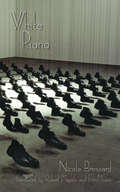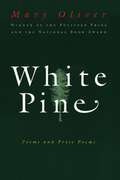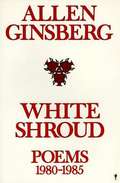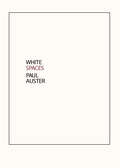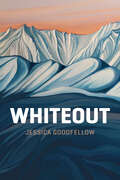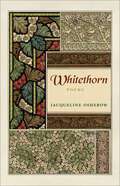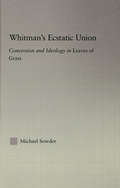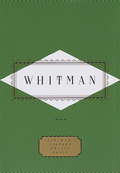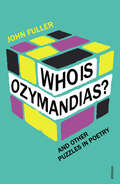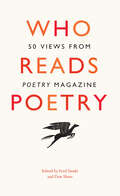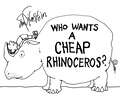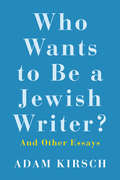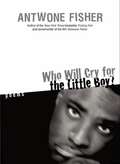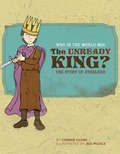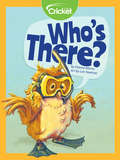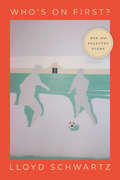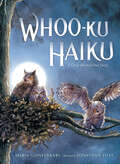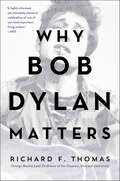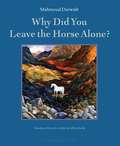- Table View
- List View
White Papers (Pitt Poetry)
by Martha CollinsThis book contains a series of untitled poems that deal with issues of race from a number of personal, historical, and cultural perspectives. Expanding the territory of the author’s 2006 book Blue Front, which focused on a lynching her father witnessed as a child, this book turns, among other things, to the author's childhood. Throughout, it explores questions about what it means to be white, not only in the poetÆs life, but also in our culture and history, even our pre-history. The styles and forms are varied, as are the approaches; some of the poems address race only implicitly, and the book, like Blue Front, includes some documentary and \u201cfound\u201d material. But the focus is always on getting at what it has meant and what it means to be white―to have a race and racial history, much of which one would prefer to forget, if one is white, but all of which is essential to remember and to acknowledge in a multi-racial society that continues to live under the influence of its deeply racist past.
White Piano
by Nicole Brossard Robert Majzels Erin MoureBetween the verbs quivering and streaming, White Piano unfolds its variations like musical scores. A play of resonance between pronouns and persons, freely percussive between prose and poetry, and narrating a constellation of questions, White Piano offers readers a 'language that cultivates its own craters of ?re and savoir-vie.'
White Pine: Poems and Prose Poems
by Mary OliverFrom the National Book Award and Pulitzer Prize winning poet Mary Oliver, a collection of evocative and haunting poetry and prose“Oliver’s poems are...as genuine, moving and implausible as the first caressing breeze of spring.” —New York TimesIn her first collection since winning the National Book Award, Mary Oliver writes of the silky bonds between every person and the natural world, of the delight of writing, of the value of silence. The collection features the fourteen-part poem “In the Blackwater Woods,” as well as “At the Lake” and the prose poem “Snail.”
White Shroud (Poems 1980-1985)
by Allen GinsbergWhite Shroud is a poetry book by Allen Ginsberg. "Old lovers yet may have All that Time denied-- Grave is heaped on grave, That they be satisfied--"
White Spaces: Selected Poems And Early Prose
by Paul Auster“Magnificent poetry; dark, severe, even harsh—yet pulsating with life.” —John Ashbery White Spaces gathers the poetry and prose of Paul Auster from various small-press books issued throughout the seventies. These early poetic works are crucial for understanding the evolution of Auster’s writing. Taut, lyrical, and always informed by a powerful and subtle music, his poems begin with basics—a swallow’s egg, stones, roots, thistle, “the glacial rose”—and push language to the breaking point. As Robert Creeley wrote, “The enduring power of these early poems is their moving address to a world all too elusive, too fragmented, and too bitterly transient.” Auster’s poems are grounded in a physical utterance that is at once an exploration of the mind and of the world. This collection begins with compact verse fragments from Spokes (originally published in Poetry, 1971) and goes through Auster’s marvelous later collections including Wall Writing (The Figures, 1976), Facing the Music (Parenthese, 1979), and White Spaces (Station Hill, 1980).
White Whispers: Selected Poems of Salabega
by Niranjan MohantyThe Book Is An Attempt To Bring To Limelight The Hidden, Unexplored Richness And Sophistication Of A 17Th Century Oriya Devotional Poet Whose Intense Piety Coupled With The Metaphoric Interiority Of The Medium Creates A Unique Kind Of Poetic Art.
Whiteout (The Alaska Literary Series)
by Jessica GoodfellowWhen she was a toddler, Jessica Goodfellow’s twenty-two-year-old uncle, along with six other climbers from the 1967 Wilcox Expedition to Denali, was lost in an unprecedented ten-day storm blasting winds of up to three-hundred miles per hour. Just as North America’s highest peak is so massive that it has its own distinct weather system—changeable and perilous, subject to sudden whiteout conditions—a family whose loved one is irretrievably lost has a grief so blinding and vast that it also creates its own capricious internal weather, one that lasts for generations. Whiteout is Goodfellow’s account of growing up in this unnavigable and often unspoken-of climate of bereavement. Although her poems begin with a missing body, they are not an elegy. Instead, Goodfellow struggles with the absence of cultural ritual for the uncontainable loss of a beloved one whose body is never recovered and whose final story is unknowable. There is no solace here, no possible reconciliation. Instead, Whiteout is a defiant gaze into a storm that engulfs both the wildness of Alaska and of familial mourning.
Whitethorn: Poems (A History of the South)
by Jacqueline OsherowIn "Poem for Jenne," which opens Jacqueline Osherow's ambitious and challenging newcollection, a neighbor has planted larkspur and delphinium in the poet's yard and is tending them hoping to bring color and light into a household stricken by personal tragedy. As the bright blue, star-shaped flowers bloom for a second time, the poet writes, "earth's reaching for her heavens, I for words / or any chink of rapture I can claim." The pervasive theme, in this poem and throughout Whitethorn, is that human suffering may be irremediable, yet in nature and language one may find a key to unlock the mysteries of sorrow.Osherow searches for that cipher by exploring a range of suffering, from the personal to the historical and cultural. In the poem "Orders of Infinity" she visits Treblinka and, in her inability to count the stones or quantify the real loss of the Holocaust, ponders the impossibility of imagining the unborn generations of the victims' descendants, an infinity of lives not lived, "undreamed daydreams, mute conversations, ungratified indulgences, failed hints..."In Whitethorn, a book of enormous scope and emotional intelligence, Osherow unflinchingly examines the pain of her own personal history and courageously probes the greater mystery of evil and suffering in the world.
Whitman's Ecstatic Union: Conversion and Ideology in Leaves of Grass (Studies in Major Literary Authors #38)
by Michael SowderFirst Published in 2005. Routledge is an imprint of Taylor & Francis, an informa company.
Whitman: Poems
by Walt WhitmanThe Everyman's Library Pocket Poets hardcover series is popular for its compact size and reasonable price which does not compromise content. Poems: Whitman contains forty-two of the American master's poems, including "Crossing Brooklyn Ferry," "Song of Myself," "I Hear America Singing," "Halcyon Days," and an index of first lines.
Who Is Ozymandias?: And other Puzzles in Poetry
by John FullerPart of the pleasure of poetry is unravelling the mysteries and difficulties it contains and solving the puzzles that lie within. Who, for instance, is Ozymandias? What is the Snark? Who is the Emperor of Ice-Cream? Or indeed, who is 'you' in a poem? In this perceptive and playful new book, acclaimed poet John Fuller looks at some of our greatest poems and considers the number of individual puzzles at their heart, casting light on how we should approach these conundrums as readers. From riddling to double entendres, mysterious titles to red herrings, Fuller unpicks the puzzles in works that range from Browning to Bishop, Empson to Eliot, Shelley to Stevens, to help us reach the rewards and revelations that lie at the centre of some of our best-loved poems.
Who Killed American Poetry?: From National Obsession to Elite Possession
by Karen L. KilcupThroughout the 19th century, American poetry was a profoundly populist literary form. It circulated in New England magazines and Southern newspapers; it was read aloud in taverns, homes, and schools across the country. Antebellum reviewers envisioned poetry as the touchstone democratic genre, and their Civil War–era counterparts celebrated its motivating power, singing poems on battlefields. Following the war, however, as criticism grew more professionalized and American literature emerged as an academic subject, reviewers increasingly elevated difficult, dispassionate writing and elite readers over their supposedly common counterparts, thereby separating “authentic” poetry for intellectuals from “popular” poetry for everyone else.\ Conceptually and methodologically unique among studies of 19th-century American poetry, Who Killed American Poetry? not only charts changing attitudes toward American poetry, but also applies these ideas to the work of representative individual poets. Closely analyzing hundreds of reviews and critical essays, Karen L. Kilcup tracks the century’s developing aesthetic standards and highlights the different criteria reviewers used to assess poetry based on poets’ class, gender, ethnicity, and location. She shows that, as early as the 1820s, critics began to marginalize some kinds of emotional American poetry, a shift many scholars have attributed primarily to the late-century emergence of affectively restrained modernist ideals. Mapping this literary critical history enables us to more readily apprehend poetry’s status in American culture—both in the past and present—and encourages us to scrutinize the standards of academic criticism that underwrite contemporary aesthetics and continue to constrain poetry’s appeal. Who American Killed Poetry? enlarges our understanding of American culture over the past two hundred years and will interest scholars in literary studies, historical poetics, American studies, gender studies, canon criticism, genre studies, the history of criticism, and affect studies. It will also appeal to poetry readers and those who enjoy reading about American cultural history.
Who Killed Cock Robin?
by Etienne DelessertAn illustrated version of the English ballad relating the murder and funeral of Cock Robin.
Who Reads Poetry: 50 Views from “Poetry” Magazine
by Don Share Fred SasakiWho reads poetry? We know that poets do, but what about the rest of us? When and why do we turn to verse? Seeking the answer, Poetry magazine since 2005 has published a column called “The View From Here,” which has invited readers “from outside the world of poetry” to describe what has drawn them to poetry. Over the years, the incredibly diverse set of contributors have included philosophers, journalists, musicians, and artists, as well as doctors and soldiers, an iron-worker, an anthropologist, and an economist. This collection brings together fifty compelling pieces, which are in turns surprising, provocative, touching, and funny. In one essay, musician Neko Case calls poetry “a delicate, pretty lady with a candy exoskeleton on the outside of her crepe-paper dress.” In another, anthropologist Helen Fisher turns to poetry while researching the effects of love on the brain, “As other anthropologists have studied fossils, arrowheads, or pot shards to understand human thought, I studied poetry. . . . I wasn’t disappointed: everywhere poets have described the emotional fallout produced by the brain’s eruptions.” Even film critic Roger Ebert memorized the poetry of e. e. cummings, and the rapper Rhymefest attests here to the self-actualizing power of poems: “Words can create worlds, and I’ve discovered that poetry can not only be read but also lived out. My life is a poem.” Music critic Alex Ross tells us that he keeps a paperback of The Palm at the End of the Mind by Wallace Stevens on his desk next to other, more utilitarian books like a German dictionary, a King James Bible, and a Macintosh troubleshooting manual. Who Reads Poetry offers a truly unique and broad selection of perspectives and reflections, proving that poetry can be read by everyone. No matter what you’re seeking, you can find it within the lines of a poem.
Who Wants a Cheap Rhinoceros?
by Shel SilversteinFrom New York Times bestselling author Shel Silverstein, acclaimed creator of Where the Sidewalk Ends, The Giving Tree, A Light in the Attic, and Falling Up, comes a boy’s tribute to a perfectly unexpected pet: a rhinoceros.In this cherished classic, published for the first time at HarperCollins, Silverstein delivers a hilarious look at the joys of having a rhinoceros as your friend, with his signature humor and black-and-white artwork.Generations have grown up with the works of Shel Silverstein, known not only as a poet and illustrator, but also for his work as a cartoonist, playwright, performer, recording artist, and Grammy Award-winning songwriter. With the timeless magic of his work, Shel Silverstein has encouraged children to dream and dare to imagine the impossible with his extraordinary poetry and unforgettable characters.Need a pet? What’s the best kind to get?A dog, a cat, a frog, a rat?How about a cheap rhinoceros?He’s funny and sweet and loyal as they come.He’s huggable and lovable.So who wants a cheap rhinoceros?Maybe you!
Who Wants to Be a Jewish Writer?: And Other Essays
by Adam KirschFrom one of today’s keenest critics comes a collection of essays on poetry, religion, and the connection between the two Adam Kirsch is one of today’s finest literary critics. This collection brings together his essays on poetry, religion, and the intersections between them, with a particular focus on Jewish literature. He explores the definition of Jewish literature, the relationship between poetry and politics, and the future of literary reputation in the age of the internet. Several essays look at the way Jewish writers such as Stefan Zweig and Isaac Deutscher, who coined the phrase “the non‑Jewish Jew,” have dealt with politics. Kirsch also examines questions of spirituality and morality in the writings of contemporary poets, including Christian Wiman, Kay Ryan, and Seamus Heaney. He closes by asking why so many American Jewish writers have resisted that category, inviting us to consider “Is there such a thing as Jewish literature?”
Who Was Walt Whitman? (Who Was?)
by Kirsten Anderson Who HQHow did a New York printer become one of the most influential poets of all time? Find out in this addition to the Who HQ library!Walt Whitman was a printer, journalist, editor, and schoolteacher. But today, he's recognized as one of America's founding poets, a man who changed American literature forever. Throughout his life, Walt journeyed everywhere, from New York to New Orleans, Washington D.C. to Denver, taking in all that America had to offer. With the Civil War approaching, he saw a nation deeply divided, but he also understood the power of words to inspire unity. So in 1855, Walt published a short collection of poems, Leaves of Grass, a book about the America he saw and believed in. Though hated and misunderstood by many at the time, Walt's writing introduced an entirely new writing style: one that broke forms, and celebrated the common man, human body, and the diversity of America. Generations later, readers can still find themselves in Whitman's words, and recognize the America he depicts. Who Was Walt Whitman? follows his remarkable journey from a young New York printer to one of America's most beloved literary figures.
Who Will Cry for the Little Boy?
by Antwone Q. FisherWith the publication of Finding Fish, his memoir of a childhood spent in foster homes in and around Cleveland, Antwone Fisher shared with the world his story of perseverance, determination, and courage. And he also showed that within him beat the heart of an artist -- a major factor in his resilience and recovery. Now with Who Will Cry for the Little Boy?, his first collection of poetry, Antwone Fisher reveals the inner truths that took him from a tumultuous childhood to the man he is today. The powerful poems presented here range from impressions and expressions of Antwone's years growing up to the love that he has gained from the family he made for himself as an adult. From the title poem -- which is featured prominently in the movie Antwone Fisher -- a plaintive, haunting tribute to a childhood lost to abuse and neglect, to "Azure Indigo," the uplifting and touching poem about his daughters, many readers will find their own feelings and experiences reflected in this lyrical and passionate collection.
Who in the World Was The Unready King?: The Story of Ethelred (Who in the World)
by Connie Clark Jed MickleDiscover the intriguing story of Ethelred the Unready in this junior-level biography from Peace Hill Press. Ethelred's mother stood behind him. The archbishop smeared holy oil on Ethelred's shoulders and hands. He gave Ethelred a heavy sword and placed a gold crown on his head. The crown was too big--it fell over his eyes, and Ethelred almost dropped the sword on the archbishop's foot. How did Ethelred become king when he was only ten years old? Outstanding illustrations from Jed Mickle complement the fabulous story, giving second-grade readers insight into the life of this influential figure. About the series: The classical curriculum introduces even the youngest student to the pleasures of true learning. Elementary students learn history not through predigested textbooks with multiple-choice answers, but through reading the stories of history. Unfortunately, biographies of great men and women of the past are almost all written for older students, limiting the ability of young students to explore history through reading. Libraries are crammed with biographies written for high school students and adults--while beginning readers are provided with a shelf full of junior-level books about football players, NASCAR drivers, and movie stars. Now, Peace Hill Press puts real history back into the grasp of the youngest historians with the Who in the World Biography Series. The first entries in the series provide young readers and their parents and teachers with biographies of great men and women of the Middle Ages. Designed to be used as part of The Story of the World curriculum, these biographies give beginning historians in grades 2-4 a chance to explore beyond the textbook. An audio version is also available separately.
Who's There?
by Dianne MoritzWhat else is there to do on a hot, summer day? Head to the flea’s pool, of course! In this funny rhyme, all the animals head to the pool to cool down.
Who's on First?: New and Selected Poems (Phoenix Poets)
by Lloyd SchwartzNew and selected poems by renowned poet Lloyd Schwartz. For more than four decades, readers and critics have found Lloyd Schwartz’s poems unlike anyone else’s—a rare combination of the heartbreaking and the hilarious. With his ear for the poetry of the vernacular, Schwartz offers us a memorable cast of characters—both real and imagined, foolish and oracular. Readers experience his mother’s piercing flashes of memory, the perverse comic wisdom of Gracie Allen, the uninhibited yet loving exhibitionists of antique pornography, and eager travelers crossing America in a club-car or waiting in a Brazilian airport. Schwartz listens to these people without judging—understanding that they are all trying to live their lives, whenever possible, with tenderness, humor, and grace.Who’s on First? brings together a selection of poems from all of Schwartz’s previous collections along with eagerly awaited new poems, highlighting his formal inventiveness in tangling and untangling the yarn of comedy and pathos. Underlying all of these poems is the question of what it takes and what it costs to make art.
Whoo-Ku Haiku: A Great Horned Owl Story
by Maria GianferrariStunning illustrations and gorgeous haikus lead young readers through the dramatic life cycle of one of America's most beloved wild animals.Pip. Pip. Pip. PokingA hole. Cracking. Cracking. OutPecks the white owlet.Watch as a pair of great horned owlets peep and squeak in their feathered nest. Mama and Papa hunt for food and fend off predators while the chicks grow strong enough to hop and flap between the branches of their tree, then leap and fly away, ready to explore the wild world around them.In this thrilling nonfiction picture book, a combination of haiku and dazzling illustration shows readers the fierce majesty of one of North America's most ubiquitous wild animals.
Why / Why Not
by Martha Clare RonkA book of short poems written in between--in between thoughts, questions, answers, conclusions. It is a stage play of a book, divided into four parts/acts and inspired by paintings, movies, Shakespeare, Chandler, and Los Angeles.
Why Bob Dylan Matters
by Richard F. Thomas“Masterful, fun . . . Thomas shows why Dylan deserves his Nobel—and how he hearkens back to, and enlists, the classics. Fantastic reading, full of gems.” —Cass R. Sunstein, Robert Walmsley University Professor, Harvard UniversityWhen the Nobel Prize for Literature was awarded to Bob Dylan in 2016, a debate raged. Some celebrated, while many others questioned the choice. How could the world’s most prestigious book prize be awarded to a famously cantankerous singer-songwriter who wouldn’t even deign to attend the medal ceremony?In Why Bob Dylan Matters, Harvard Professor Richard F. Thomas answers this question with magisterial erudition. A world expert on Classical poetry, Thomas was initially ridiculed by his colleagues for teaching a course on Bob Dylan alongside his traditional seminars on Homer, Virgil, and Ovid. Dylan’s Nobel Prize brought him vindication, and he immediately found himself thrust into the spotlight as a leading academic voice in all matters Dylanological. Today, through his wildly popular Dylan seminar—affectionately dubbed “Dylan 101” —Thomas is introducing a new generation of fans and scholars to the revered bard’s work.This witty, personal volume is a distillation of Thomas’s famous course, and makes a compelling case for moving Dylan out of the Rock & Roll Hall of Fame and into the pantheon of Classical poets. Asking us to reflect on the question, “What makes a classic?”, Thomas offers an eloquent argument for Dylan’s modern relevance, while interpreting and decoding Dylan’s lyrics for readers. The most original and compelling volume on Dylan in decades, Why Bob Dylan Matters will illuminate Dylan’s work for the Dylan neophyte and the seasoned fanatic alike. You’ll never think about Bob Dylan in the same way again.“The coolest class on campus.” —The New York Times
Why Did You Leave the Horse Alone?
by Mahmoud Darwish Jeffrey SacksAt once an intimate autobiography and a collective memory of the Palestinian people, Darwish's intertwined poems are collective cries, songs, and glimpses of the human condition. Why Did You Leave the Horse Alone? is a poetry of myth and history, of exile and suspended time, of an identity bound to his displaced people and to the rich Arabic language. Darwish's poems - specific and symbolic, simple and profound - are historical glimpses, existential queries, chants of pain and injustice of a people separated from their land.

